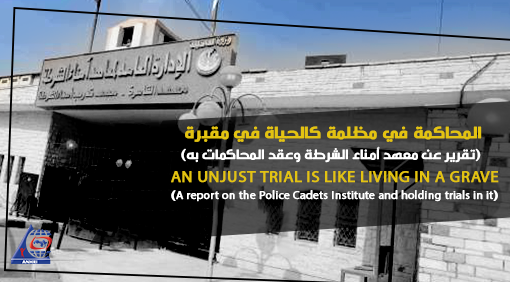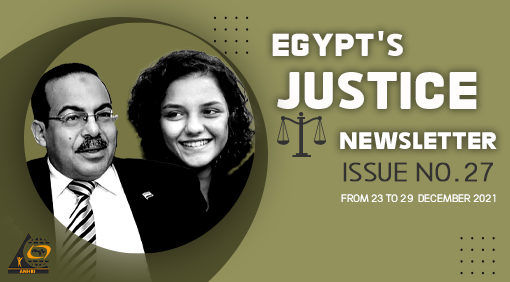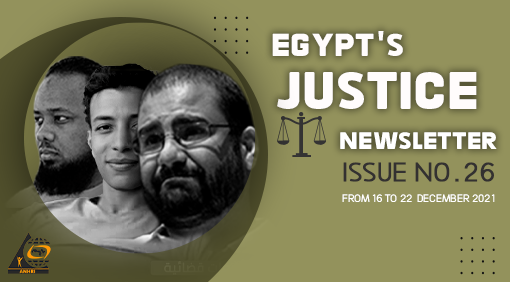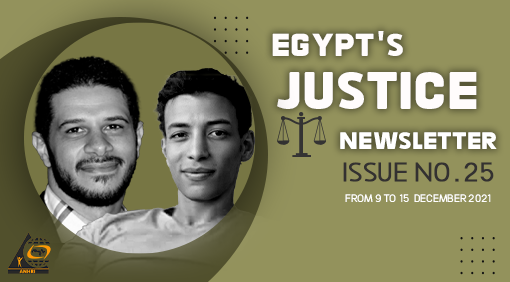
Question: Imagine that you will be brought to trial over an offence- whether you committed it, or whether it is fabricated against you- at Iraq’s Abu Ghraib prison, or the American Alcatraz prison, or Tadmur prison in Syria, or Iran’s Evan prison. How would you feel about it?
You might feel panic, anger, or intense fear; since these prisons haven’t gained their notoriety for merely being prisons, but rather due to the violations, torture, and inhumane treatment that took place within their walls.
This is not a mere feeling or imagination. This is what actually happens to thousands of detainees and prisoners in Egypt who are being brought to trial in the “Police Cadets Institute”.
This is not a prison, and it wasn’t. It is a hotbed of torture, although, on paper, it was an institute for teaching the legal and police syllabus for those who have intermediate-level qualifications so as to become police officers, equivalent to the rank of “Constable” in the British Police.
The institute, however, was used as a hotbed of torture during the rule of ousted dictator Hosni Mubarak.
Then it became, for seven years, the main venue for political trials, real or fabricated.
So let’s get to know its story…
The Police Cadets Institute: its origins:
The Police Cadets Institute was established in the late Nasser era, in the late 1960s, with the aim of graduating batches of educated police officers to promote police civic engagement with citizens and the rehabilitation of ordinary young citizens to become police officers after serving 15 years as a low-ranking policeman (police cadet), especially that the Police College has strict military conditions for admission, not to mention the so-called “social background check”, which is mainly a class-based criteria that is related to the individual’s wealth and social status.
This was the goal, or at least the public goal. We cannot be certain about the undeclared goals of the former Minister of Interior Sharawi Gomaa who founded this institute, but we can affirm that the final outcome of its establishment, and the graduation of batches of police cadets to serve as the link between citizens and police officers, is really unpleasant.
In short, police cadets are the Ministry of Interior’s personnel that roam the streets to carry out rule and order. They are also the brutal fist that awaits and carries out the orders of the “Pasha”; neither the police recruits nor any other low-ranking officers have the authority to suppress citizens, and it’s not appropriate for high-ranking police officers to come down off of their soaring height and mingle with common people such as drivers and street vendors. Hence, police cadets are the authorities’ ambassadors to the public, against whom they carry out the policies set by the Ministry of the Interior.
The Police Cadets Institute’s location
The authorities chose the Tora area to be the location of the Police Cadets Institute. They chose this location because it encompasses Tora Prison Complex, the largest and oldest prison complex area in Egypt. The institute was established near the “Istiqbal” Prison, Tora Farms Prison, and the Maximum-Security Prison on the “Autostrad” highway, and it is also close to Tora Investigation Prison on the Nile Corniche. These factors combined made the entire area a military barracks for the Egyptian Ministry of Interior, which often closes the only road connecting the Autostrad Road to the Nile Corniche on the grounds that it passes between Tora’s camps and prisons.
The Police Cadets Institute’s obscure history
“We used to wake up in the middle of the night to the cell’s door squeaking on the floor as it opens for grabbing a prisoner from among us, taking him away for an hour or two, and sometimes for 5 hours. Then we woke up again to the same sound with the prisoner returning to the cell, who left struggling with signs of sleepiness but returned suffering from torture. He told us that they took him to the Police Cadets Institute where torture is used to extract confessions or as a form of punishment”, human rights lawyer Gamal Eid reported while speaking about his imprisonment in 1994. (1)
Eid added, in his testimony: “We could hear victims screaming although the Istiqbal Prison, where we were held, is 150 meters away from the Police Cadets Institute, but sound travels farther at night. Torturers feel assured their brutality will go unpunished”.
In a 2005 study conducted by the Egyptian Interior Ministry about the number of military trials and their perpetrators, the ‘police representatives’ ranked highest in terms of committing the highest numbers of violations, followed by the ‘police cadets’. Consequently, a decision was issued to cancel the Institute of Police Representatives, and their numbers were compensated for by increasing the number of those admitted to non-commissioned officers and soldiers’ institutes and promoting those who fulfill the requirements to the rank of Police Cadet.
Then in February 2016, the parliament took an initiative to abolish the Institute of Police cadets in response to the latter’s successive protests and their permanent demands to eliminate the stereotyped images largely adopted by people towards them and to change their conditions as well. (2)
After the Police Academy, trials in the Police Cadets Institute kicked off
The trial of former dictator Hosni Mubarak marked the beginning of what is known as phenomenon of “The Trial at the Ministry”; meaning that the trials which ought to have been held in courts affiliated with the Ministry of Justice are now being held at the Ministry of Interior’s police facilities (rather than at those of the Ministry of Justice). Mubarak’s first and most important trial was held in the summer of 2011 at the Police Academy in New Cairo!
Mubarak’s trial was the first to be held at one of the facilities under the Interior Ministry’s control, but it was not the last.
In September 2013, Counselor Nabil Salib, President of the Cairo Court of Appeal, announced the preparation of a courtroom within the Police Cadets Institute in Tora for criminal trials, in coordination with the Ministry of Interior, to be similar to the courtrooms inside the Police Academy.
Also, in December 2013, the Minister of Justice decided to aggregate the Police Cadets Institute among the judicial circuits to consider terrorism cases. (3)
Since then, trials at the Police Cadets Institute have escalated and expanded, and instead of considering the institute as an exceptional location for trials of a special (political) nature, it has become the main venue for the majority of trials in opinion and political cases.
The exception became the rule… Indicative figures:
Since 2013, when the first trial at the Police Cadets Institute took place, the institute has become the main venue for the majority of political trials, and the one courtroom it had became six in only 7 years, as follows:
– Number of courtrooms till 2019: Three (rooms 1, 2, 3)
– In 2020, a new building- established in late 2019- was used for the conducting of trials, and it has three new courtrooms: (4, 5, 6)
– Courtrooms No. 4 and 6 for State Security cases, courtroom No. 5 for military trials, and courtrooms No. 1, 2 and 3 (are currently closed).
– The total number of political trial sessions that took place as monitored by ANHR during 2019 is: 1331 sessions, out of which 783 were conducted inside the Police Cadets Institute.
– The total number of political trial sessions as monitored by ANHR during 2020 “until November” is: 1048 sessions, out of which 624 were conducted inside the Police Cadets Institute.
The outcome:
- 6 trial courtrooms at the Ministry of Interior-affiliated Police Cadets Institute
- 60% of the political trial sessions that took place in 2019 were conducted in the Police Cadets Institute
- 65% of the political trial sessions that took place in 2020 were conducted in the Police Cadets Institute
“Injustice anywhere is a threat to justice everywhere”- Martin Luther King Jr.
The absence of the conditions of a public trial inside the Police Cadets Institute:
The principle of public trials means that the trial can be accessible to anyone from the public, not just to litigants or lawyers. The public may include mass audiences and ordinary citizens regardless of their background, gender, and education (whether educated or illiterate, man or woman). It also refers to the public opinion’s right to know about the course of a trial as reported by journalists who attend the trial hearings.
So, does this happen at the Police Cadets Institute?
– No, since the trial sessions are conducted inside a police facility, and therefore, if you are a lawyer, journalist, or a citizen (family members and relatives of the defendant being tried) you will evidently be subjected to some sort of harassment or abuse, and you will probably be searched before entering the courtroom of the institute.
At first, lawyers and journalists used to enter the Police Cadets Institute with their mobile phones, and journalists were allowed to use their cameras in the courtroom to film, photograph, or record important trial sessions and to follow the court proceedings. This is based on the legal principle of public hearings. But over time, this principle has been violated; as lawyers, who are one of the major elements of justice, face severely intransigent security measures every time they enter the courtroom inside the institute. Lawyers, particularly female lawyers, are inappropriately searched before entering the institute, and they are stripped of their mobile phones, and consequently, defendants lose contact with the outside world during their detention at the Police Cadets Institute. This is in addition to preventing the defendants’ families from attending the trial hearings or seeing their relatives, especially that in many cases family visits are prohibited and hence families have no other way to see their relatives and make sure that they are fine except by attending their trial sessions.
Is it permissible to hold a trial at the Ministry of Interior’s facilities?
In the spring of 2014, journalist and activist Ahmed Doma was beaten by the Police Cadets Institute’s security personnel, and during his trial, he declared before the judge that he had been physically assaulted. He also submitted an official complaint which shows evidence of personal grudges between the activist and the institute’s officials who belong to the Ministry of the Interior. It has been six years since the assault took place, but none of the assailants have been held accountable so far. (4)
The sense of justice is absent in a justice establishment facility
You are, presumably, being tried in a facility that belongs to the Ministry of Interior and that is located in an area that is completely affiliated with the Ministry of the Interior, adding that this facility is known for being a hotbed of torture. A few years ago, as soon as you enter the courtroom, you will find yourself inside an iron cage enclosed within soundproof glass; you’ll hardly see your lawyer- if he is allowed to attend your trial hearing- and you’ll not be able to speak with him, nor with the judge, unless the microphone is opened and you are allowed to speak. You’ll not be able to voice your opinion, share any remarks, or comment on the judge, lawyer or witnesses’ testimonies in case the microphone is switched off.
This is how trials in the Police Cadets Institute, the main venue for trial hearings, look like!
Examples of trials held at the Police Cadets Institute
1- “Spying for Hamas” Case
It is the case in which ousted president Mohamed Morsi dies during the trial proceedings, after he lost consciousness inside the defendants’ “cage” in the courtroom of the Police Cadets Institute.
It is worth noting that the defendants’ “cage” within the Police Cadets Institute is a soundproof glass cage, which is designed to prevent the defendants from hearing the judge without the latter’s permission and from speaking to the judge or lawyers.
Morsi had been sentenced to life imprisonment in the case known in the media as “spying for Qatar”, to 20 years in a high-security prison in the case publicly known as “Ittihadiya Palace incidents”, and to 3 years in prison in the case of “insulting the judiciary”. (5)
2- “Insulting the judiciary” Case
The Public Prosecution had referred the following to the criminal court: Essam Sultan, Mahmoud al-Khudairi, Mohamed Saad al-Katatni, Mohamed al-Beltagy, Sobhi Saleh, Mustafa al-Nagar, Mohamed Mahmoud Hamed, Mohamed Munib, Hamdi al-Fakharani, Mahmoud Ezz al-Arab, Amr Hamzawy, Mohamed al-Muntasir, Abd al-Halim Qandil, Nur al-Din al-Haddad, Ahmad Hassan al-Sharqawi, Tawfiq Okasha, Amir Salem, Assem Abdel-Maged, Wagdy Ghoneim, Abdel-Rahman al-Qaradawi, Alaa Abdel Fattah, Mohamed Morsi Al-Ayyat, Ahmed Abu Baraka, and Mohamed Mahsoub. The aforementioned were accused of: insulting the judiciary and defaming its members making statements on television or on social networking websites with the aim to spread hate against judges. (6)
The trials were held at the Police Cadets Institute, before the court ruled to accept the appeals filed by the defendants, and ordered them to pay fines.
3- “The dispersal of Rabaa Sit-in” Case
Among the most prominent defendants accused in this case are: Mohamed Badei, the Muslim Brotherhood General Guide, and the MB leading members: Essam Al- Arian (died in prison), Essam Maged, Abdel-Rahman Al-Barr, Safwat Hegazi, Mohamed al-Beltagy, Osama Yassen, Essam Sultan, Basem Odeh, Wagdi Ghoneim, Osama Mohamed Morsi (son of ousted president Mohamed Morsi), Mahmoud Shawkan, and others. The aforementioned defendants were referred to the criminal court in August 2015 on charges of “Gathering, display of force, premeditated murder, vandalism, and unlicensed possession of explosive materials and firearms”. (7)
4- “The Oppressed of Downtown” Case
The case dates back to 25 January 2014, when the police arrested 227 citizens protesting in front of the Journalists Syndicate in the vicinity of Downtown Cairo, in conjunction with the third anniversary of the January Revolution. The citizens were then referred to the Public Prosecution for investigation into the aforementioned case, before they were brought to trial on charges of “Taking part in an assembly, possessing weapons and ammunition without a license, and display of force”. The court acquitted the defendants of the “premeditated murder and attempted murder” charges. (8)
5- Other cases:
Al-Fath Mosque;
The Republican Guard;
Spying for foreign countries;
The prison raids;
Al-Istiqama Mosque incidents;
Al-Bahr Al-Aazam incidents;
Rabaa Operations Room;
The raid on Al-Tebbein Police Station;
Al-Nusra Front
Conclusion
If you can live in a grave, you might understand how it feels to be tried unjustly!
The Police Cadets Institute, with its history, location and the nature of its courtrooms, is not an appropriate place for handing out justice and the implementation of the rule of law.
Given the atrocious human rights record of the Interior Minister Shaarawi Gomaa, who founded the institute, and the nature of trials, which are mostly conducted against January Revolution’s figures and affiliates, let alone the suppression of the police cadets’ coalition movement, which broke out to eliminate their stereotyped image, after the police’s practices drew the ire of the Egyptian people as the January Revolution erupted on the Police Day, we can say that the Police Cadets Institute is not the appropriate nor the right place for holding trials whose purpose, supposedly, is to achieve justice.
The regime’s insistence on holding trials at the Police Cadets Institute on the pretext of “security reasons” sends a message to citizens that protecting the regime’s interests is above everything else, including justice.
for PDF
for word
((Footnotes))
- An interview with former prisoner of conscience Gamal Eid speaking about his imprisonment the mid-1990s
- Al-Arabiya news website, February 2016, accessed on: 2020
- Al-Masry Al-Youm news website, published in: December 2013, accessed in: December 2020
https://www.almasryalyoum.com/news/details/365187
- Pro-regime “Mobtada” news website, published on: March 20, 2014, accessed on: December 4, 2020
https://www.mobtada.com/details/165845
- BBC Arabic, published in: August 2019, accessed in: December 2020
https://www.bbc.com/arabic/middleeast-49497037
- Al-Masry Al-Youm news website, published in: October 2019, accessed in: December 2020
https://www.almasryalyoum.com/news/details/1437197
- Al Mal news website, published in: October 2020, accessed in: December 2020
https://almalnews.com/%D8%AA%D8%A3%D8%AC%D9%8A%D9%84-%D8%B7%D8%B9%D9%88%D9%86-%D8%A7 % D9% 84% D9% 85% D8% AA% D9% 87% D9% 85% D9% 8A% D9% 86-% D9% 81% D9% 8A-% D9% 82% D8% B6% D9% 8A % D8% A9-% D9% 81% D8% B6-% D8% A7% D8% B9% D8% AA% D8% B5% D8% A7% D9% 85-% D8% B1 /
- Daarb news website, published in: October 2020, accessed in: December 2020
https://daaarb.com/%D9%85%D8%AD%D9%83%D9%85%D8%A9-%D8%A7%D9%84%D9%86%D9%82%D8%B6- % D8% AA% D8% A4% D8% AC% D9% 84-% D9% 82% D8% B6% D9% 8A% D8% A9-% D9% 85% D8% B8% D8% A7% D9% 84 % D9% 8A% D9% 85-% D9% 88% D8% B3% D8% B7-% D8% A7% D9% 84% D8% A8% D9% 84% D8% AF /







